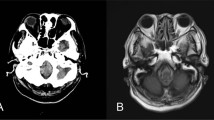Abstract
Introduction
The authors present the case of a 5-year-old girl with traumatic hydrocephalus secondary to a retroclival haematoma associated with atlanto-occipital dislocation (AOD) after a motor vehicle accident. Clinical history and neuroimaging of the patient are described.
Discussion
Computed tomography (CT) imaging of the head revealed a retroclival haematoma with secondary hydrocephalus. The cranio-cervical junction showed an AOD that was initially overlooked. Traumatic AOD is a rare diagnosis although in the recent years it has become an emergent entity due to the improvement of emergency medical treatment on the field.
Conclusion
An initial diligent imaging study and interpretation should be made to avoid misdiagnosis and to provide adequate treatment. This is the first case reported of the association of AOD, hydrocephalus and retroclival haematoma. A brief review of the literature is also presented.


Similar content being viewed by others
References
Agrawal D, Cochrane DD (2006) Traumatic retroclival epidural hematoma: a pediatric entity? Childs Nerv Syst 22(7):670–673
Avellino AM, Mann FA, Grady MS, Chapman JR, Ellenbogen RG, Alden TD et al (2005) The misdiagnosis of acute cervical spine injuries and fractures in infants and children: the 12-year experience of a level I pediatric and adult trauma center. Childs Nerv Syst 21(2):122–127
Brinkman W, Cohen W, Manning T (2003) Posterior fossa subarachnoid hemorrhage due to an atlantoocipital dislocation. AJR Am J Roentgenol 180:1476
Bulas DI, Fitz CR, Jonhson DL (1993) Traumatic atlanto-occipital dislocation in children. Radiology 188:155–158
Donahue DJ, Muhlbauer MS, Kaufman RA, Warner WD, Sanford RA (1994) Childhood survival of atlantooccipital dislocation: underdiagnosis, recognition, treatment, and review of the literature. Pediatr Neurosurg 21:105–111
Fisher CG, Sun JC, Dvorak M (2001) Recognition and management of atlanto-occipital dislocation: improving survival from an often fatal condition. Can J Surg 44:412–420
Guillaume D, Menezes AH (2006) Retroclival hematoma in the pediatric population. Report of two cases and review of the literature. J Neurosurg 105(4 Suppl):321–325
Harris MB, Duval MJ, Davis JA Jr, Bernini PM (1993) Anatomical and roentgenographic features of atlantooccipital instability. J Spinal Disord 6:5–10
Hosalkar HS, Cain EL, Horn D, Chin KR, Dormans JP, Drummond DS (2005) Traumatic atlanto-occipital dislocation in children. J Bone Joint Surg Am 87:2480–2488
Houle P, McDonnell DE, Vender J (2001) Traumatic atlanto-occipital dislocation in children. Pediatr Neurosurg 34:193–197
Hurbert RJ (2000) Methylprednisolone for acute spinal cord injury: an inappropriate standard of care. J Neurosurg 93:1–7
Mizushima H, Kobayashi N, Sawabe Y, Hnakawa K, Jinbo H, Iida M et al (1998) Epidural hematoma of the clivus. J Neurosurg 88:590–593
Pang D, Sahrakar K, Sun PP (1996) Pediatric spinal cord and vertebral column injuries. In: Youmans JR (ed) Neurological surgery: a comprehensive reference guide to the diagnosis and management of neurosurgical problems, vol 3. Saunders, Philadelphia, pp 1991–2036
Short D (2001) Is the role of steroids in acute spinal cord injury now resolved? Curr Opin Neurol 14:759–763
Suliman HM, Merx HL, Wesseling P, Sluijs B, Vos PE, Thijssen HOM (2001) Retroclival extradural hematoma is a magnetic resonance imaging diagnosis. J Neurotrauma 11:1289–1293
Sun PP, Poffenbarger GJ, Durham S, Zimmerman RA (2000) Spectrum of occipitoatlantoaxial injury in young children. J Neurosurg 93:28–39
Author information
Authors and Affiliations
Corresponding author
Rights and permissions
About this article
Cite this article
Vera, M., Navarro, R., Esteban, E. et al. Association of atlanto-occipital dislocation and retroclival haematoma in a child. Childs Nerv Syst 23, 913–916 (2007). https://doi.org/10.1007/s00381-007-0338-1
Received:
Revised:
Published:
Issue Date:
DOI: https://doi.org/10.1007/s00381-007-0338-1




